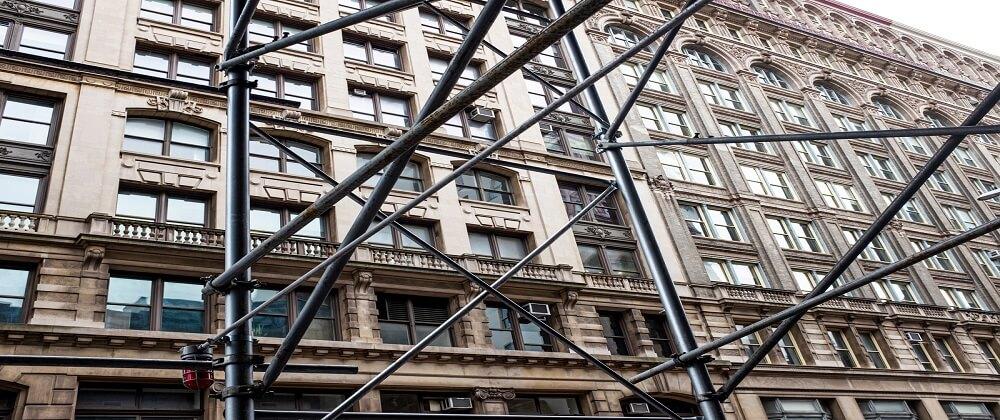
Why Is There So Much Scaffolding in New York?
By: ROS Team
New York City is famous for its skyline. But it’s also recognized for its scaffolding. You can easily spot it everywhere, either through the many iconic buildings or recent skyscrapers. This manufactured framework may appear to be an eyesore but it does play a vital role. In this article, we will try to come up with the reasons why the New York scaffolding is at the highest level and what the stumbling block is.
What is Scaffolding?
Scaffolding is a temporary structure, typically made of metal poles and wooden planks. It is erected around buildings to provide access for construction, maintenance, or renovation work. It serves as a platform for workers and equipment, ensuring safety and facilitating tasks such as painting, repairs, or facade inspections.
Scaffolding is crucial in urban environments like New York City, where numerous buildings require ongoing maintenance and development.

Why Is There So Much Scaffolding in New York?
The growth of scaffolding in New York can be traced back to the implementation of Local Law 11, which was implemented following a tragic incident in 1979 when Grace Gold, a Barnard College freshman, was killed by a falling piece of masonry. This event highlighted the urgent need for strict building safety regulations to protect pedestrians from similar accidents.
As a result, Local Law 11 requires that every building in New York City taller than six stories must undergo regular inspections by a certified engineer or architect.
These professionals assess the structural integrity of the buildings and categorize them as either:
- Safe – Means no immediate risk.
- SWARMP (Safe With a Repair and Maintenance Program) – Indicated that the building requires ongoing maintenance.
- Unsafe – Denotes a need for urgent repairs to prevent potential hazards.
Due to the rigorous demands of LL11, many buildings opt to leave scaffolding in place even between inspection periods.
This is because they anticipate that subsequent inspections will likely require additional repairs. Making it more cost-effective to maintain the scaffolding rather than repeatedly erect and dismantle it. Consequently, the scaffolding has become an ever-present feature of the city’s landscape.
The enactment of Local Law 11 has spurred the growth of the scaffolding industry in New York City. This sector now comprises a network of private inspectors and companies that provide and maintain these protective structures.
The industry’s expansion is supported by its own trade group, the Special Riggers Association, which actively lobbies city officials to influence regulations in their favor.
Changing the rules surrounding scaffolding and sidewalk sheds is a complex process. It involves navigating a web of stakeholders and addressing multifaceted issues, including safety concerns, economic interests, and regulatory challenges.
As such, the presence of scaffolding throughout New York City is not merely a temporary inconvenience but a reflection of ongoing efforts to balance public safety with the practicalities of urban maintenance and development.
What Is NYC Scaffold Law?
The NYC Scaffold Law, formally Section 240 of the New York Labor Law, is a unique regulation designed to protect construction workers from gravity-related injuries. It holds owners and contractors strictly liable for any such injuries sustained while workers are engaged in tasks like:
- Erecting, demolishing, repairing, altering, painting, cleaning, or pointing a building or structure
- Working 20 feet or more above the ground or floor
Strict liability means these parties are responsible for providing proper safety equipment regardless of fault, making it easier for injured workers to recover damages. This includes ensuring:
- Scaffolding meets specific safety standards like having guardrails and secure fastenings.
- The ladders are in good condition and used properly.
- Other appropriate fall protection is provided.
How Much Scaffolding in New York?
According to the Buildings Department, there are approximately 8,980 active sheds in New York with Manhattan leading the line with 4,000 active sheds.
Do You Know: “As per records, one shed on the Grand Concourse in the Bronx and another in the Wingate section of Brooklyn have stood since 2011.”
How Long Does Scaffolding Typically Remain in Place?
The timeframe for how long scaffolding remains in place during construction or renovation projects in New York City varies widely depending on the scope and complexity of the work, regulatory requirements, and any unforeseen issues that may arise.
Typically, scaffolding can be up for several months to a few years. Still, due to the stringent demands of Local Law 11, some buildings may keep scaffolding in place for extended periods to anticipate future inspections and repairs, resulting in a more prolonged presence.
Will NYC Ever Get Rid of Scaffolding?
Eliminating scaffolding in NYC is unlikely. Safety regulations and constant construction mean it’ll always play a role. However, initiatives like “Get Sheds Down” aim for faster removal and improved aesthetics. So, expect fewer, sleeker scaffolds, not a complete disappearance.








